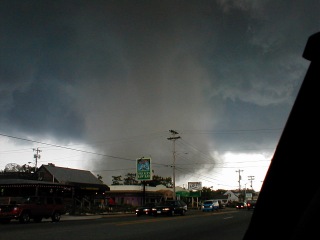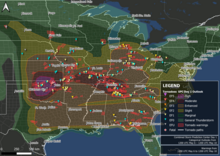
A | B | C | D | E | F | G | H | CH | I | J | K | L | M | N | O | P | Q | R | S | T | U | V | W | X | Y | Z | 0 | 1 | 2 | 3 | 4 | 5 | 6 | 7 | 8 | 9
Note: Tornadoes are very dangerous and potentially deadly. Always take tornado warnings seriously and immediately seek shelter. |
The Tornadoes Portal

Selected tornado article -

Storm chasing is broadly defined as the deliberate pursuit of any severe weather phenomenon, regardless of motive, but most commonly for curiosity, adventure, scientific investigation, or for news or media coverage. A person who chases storms is known as a storm chaser or simply a chaser.
While witnessing a tornado is the single biggest objective for most chasers, many chase thunderstorms and delight in viewing cumulonimbus and related cloud structures, watching a barrage of hail and lightning, and seeing what skyscapes unfold. A smaller number of storm chasers attempt to intercept tropical cyclones and waterspouts. (Full article...)Selected tornado list -
This page documents confirmed tornadoes in October, November, and December 2020 via various weather forecast offices of the National Weather Service. Based on the 1991–2010 averaging period, 61 tornadoes occur across the United States throughout October, 58 through November, and 24 through December.
Similar to the previous two months, a large portion of the tornadoes that touched down in October were produced by tropical cyclones, although it was still well below average with only 19 tornadoes being confirmed with no significant (EF2+) tornadoes being confirmed. November saw one tropical tornado and only isolated to scattered activity occurred elsewhere, causing the month to also fall significantly below average with only 24 tornadoes. December tornado activity did not start until about midway through the month, but a small outbreak did occur between December 23-24. There were 27 tornadoes during the month, which was comparable to the average. (Full article...)Selected image -

Selected tornado year -
Related portals
2024 tornado activity
A large, deadly and major tornado outbreak occurred across the Central and Southern United States from May 6–10, 2024, as a result of a slow-moving trough that was moving across the country. The Storm Prediction Center (SPC) issued a tornado-driven high risk convective outlook for portions of central Oklahoma and extreme southern Kansas early on May 6. Millions of people were put under a particularly dangerous situation (PDS) tornado watch later that evening, as many tornadoes were reported across the region, particularly in Oklahoma, where a violent EF4 tornado struck the towns of Barnsdall and Bartlesville, Oklahoma. Severe and tornadic weather spread eastward over the Mississippi, Ohio, and Tennessee Valleys over the next two days, with a nocturnal outbreak occurring in the latter on May 8, as tornadic supercell thunderstorms produced many tornadoes across the states of Tennessee, northern Alabama and western Georgia. The system responsible for the outbreak finally moved offshore by May 10 after producing several more tornadoes across the Southeast, including 2 EF2 tornadoes and hurricane-strength straight-line winds that moved through Tallahassee. This large outbreak came less than two weeks after a similarly large and deadly outbreak occurred across most of the same regions.
Three fatalities directly linked to the tornadoes have been confirmed so far, with the majority in Oklahoma; one tornadic death also occurred in Tennessee on May 8. Three non-tornadic deaths related to straight-line winds also occurred. In addition, during the course of the outbreak, tornado emergencies were issued for three consecutive days between May 6–8 for damaging tornadoes; the last time that this phenomenon had occurred was exactly 21 years prior, where tornado emergencies were issued for four consecutive days between May 6–9, 2003, during a similarly large outbreak.
167 tornadoes have been confirmed from the outbreak overall, most of which were clustered around Oklahoma, Michigan, Tennessee, and Alabama, earning 51 points on the outbreak intensity score. (Full article...)List of 2024 tornado articles
|
|---|
Tornado anniversaries
June 5
- 1908 – An outbreak produced multiple violent tornadoes near the Kansas/Nebraska state line, killing 20 people. An F5 tornado killed 12 people as it traveled from near Deshler, Nebraska, across the eastern part of Carleton to near Geneva. Several farms were so completely destroyed that there was little evidence that they had even existed. Five people died in one family.
- 1916 – A tornado outbreak killed at least 99 people across the Central United States, with most of the deaths in Arkansas. An F4 tornado or tornado family killed at least 25 people on a path from near Barney to near Almond, Arkansas, including at least 18 in the devastation of Heber Springs. An F3 tornado destroyed a small community near Judsonia, Arkansas, killing nine people, including five children in one family. Another F3 tornado killed seven people, all in one house, near Sikeston, Missouri.
- 1917 – A tornado outbreak resulted in at least 49 deaths across the Midwestern United States. An F4 tornado killed 20 people in Cooper and Boone Counties, Missouri, including 7 in Centralia. Another F4 tornado killed nine people as it obliterated farms near Topeka, Kansas. An F3 tornado killed nine people as it passed between Norwood and Mountain Grove, Missouri.
June 6
- 1974 – Scattered tornadoes touched down across the Midwestern and Southeastern United States. An F3 tornado damaged or destroyed 300 homes in Forrest City, Arkansas, killing four people and injuring 112.
June 7
- 1947 – An F4 tornado passed south of Vienna, Ohio and through Sharon and Farrell, Pennsylvania, killing six people and injuring 340. About 150 buildings were destroyed, and many people were injured in the collapse of apartment buildings and factories.
Did you know…
- ...that the 2013 Moore tornado that struck Moore and Newcastle, Oklahoma, is the most recent EF5 tornado?
- ...that the 2021 South Moravia tornado, an IF4 tornado with winds between 207–260 mph (333–418 km/h), was the strongest tornado to hit the Czech Republic in modern history?
General images -

From May 2 to 8, 1999, a large tornado outbreak took place across much of the Central and parts of the Eastern United States, as well as southern Canada. During this week-long event, 152 tornadoes touched down in these areas. The most dramatic events unfolded during the afternoon of May 3 through the early morning hours of May 4 when more than half of these storms occurred. Oklahoma experienced its largest tornado outbreak on record, with 70 confirmed. The most notable of these was the F5 Bridge Creek–Moore tornado which devastated Oklahoma City and suburban communities. The tornado killed 36 people and injured 583 others; losses amounted to $1 billion, making it the first billion-dollar tornado in history. Overall, 50 people lost their lives during the outbreak and damage amounted to $1.4 billion.
On May 2, a strong area of low pressure moved out of the Rocky Mountains and into the High Plains, producing scattered severe weather and ten tornadoes in Nebraska. The following day, atmospheric conditions across Oklahoma became significantly more favorable for an outbreak of severe weather. Wind profiles across the region strongly favored tornadic activity, with the Storm Prediction Center stating, "it became more obvious something major was looming" by the afternoon hours. Numerous supercell thunderstorms developed across the state as well as bordering areas in Kansas and Texas. Over the following 48 hours, May 3–4, 116 tornadoes touched down across the Central United States. Following the extensive outbreak, activity became increasingly scattered from May 5 to 8, with 26 tornadoes touching down across the Eastern United States and Quebec.
(Full article...)List of Featured articles and lists
|
|---|
Topics
Subcategories
Related WikiProjects
The scope of WikiProject Severe weather is to write articles about severe weather, namely thunderstorms and tornadoes. Their talk page is located here.
WikiProject Weather is the main hub for all articles that are weather-related. WikiProject Weather strives to improve articles in a variety of weather topics, including Tropical Cyclones, Severe Weather, General meteorology, Non-tropical Storms, Climate, Floods, Droughts and wildfires, Meteorological instruments and data, Meteorological Biographies, and Space Weather. If you would like to help, please visit the project talk page.
WikiProject Meteorology is a collaborative effort by dozens of Wikipedians to improve the quality of meteorology- and weather-related articles. If you would like to help, visit the project talk page, and see what needs doing. The project is currently being merged into WikiProject Weather.
WikiProject Tropical cyclones is a daughter project of WikiProject meteorology. The dozens of semi-active members and several full-time members focus on improving Wikipedia's coverage of tropical cyclones.
Wikipedia is a fully collaborative effort by volunteers. So if you see something you think you can improve, be bold and get to editing! We appreciate any help you can provide!
Things you can do
Wikimedia
The following Wikimedia Foundation sister projects provide more on this subject:
-
Commons
Free media repository -
Wikibooks
Free textbooks and manuals -
Wikidata
Free knowledge base -
Wikinews
Free-content news -
Wikiquote
Collection of quotations -
Wikisource
Free-content library -
Wikiversity
Free learning tools -
Wikivoyage
Free travel guide -
Wiktionary
Dictionary and thesaurus
Text je dostupný za podmienok Creative Commons Attribution/Share-Alike License 3.0 Unported; prípadne za ďalších podmienok. Podrobnejšie informácie nájdete na stránke Podmienky použitia.
Antropológia
Aplikované vedy
Bibliometria
Dejiny vedy
Encyklopédie
Filozofia vedy
Forenzné vedy
Humanitné vedy
Knižničná veda
Kryogenika
Kryptológia
Kulturológia
Literárna veda
Medzidisciplinárne oblasti
Metódy kvantitatívnej analýzy
Metavedy
Metodika
Text je dostupný za podmienok Creative
Commons Attribution/Share-Alike License 3.0 Unported; prípadne za ďalších
podmienok.
Podrobnejšie informácie nájdete na stránke Podmienky
použitia.
www.astronomia.sk | www.biologia.sk | www.botanika.sk | www.dejiny.sk | www.economy.sk | www.elektrotechnika.sk | www.estetika.sk | www.farmakologia.sk | www.filozofia.sk | Fyzika | www.futurologia.sk | www.genetika.sk | www.chemia.sk | www.lingvistika.sk | www.politologia.sk | www.psychologia.sk | www.sexuologia.sk | www.sociologia.sk | www.veda.sk I www.zoologia.sk








































